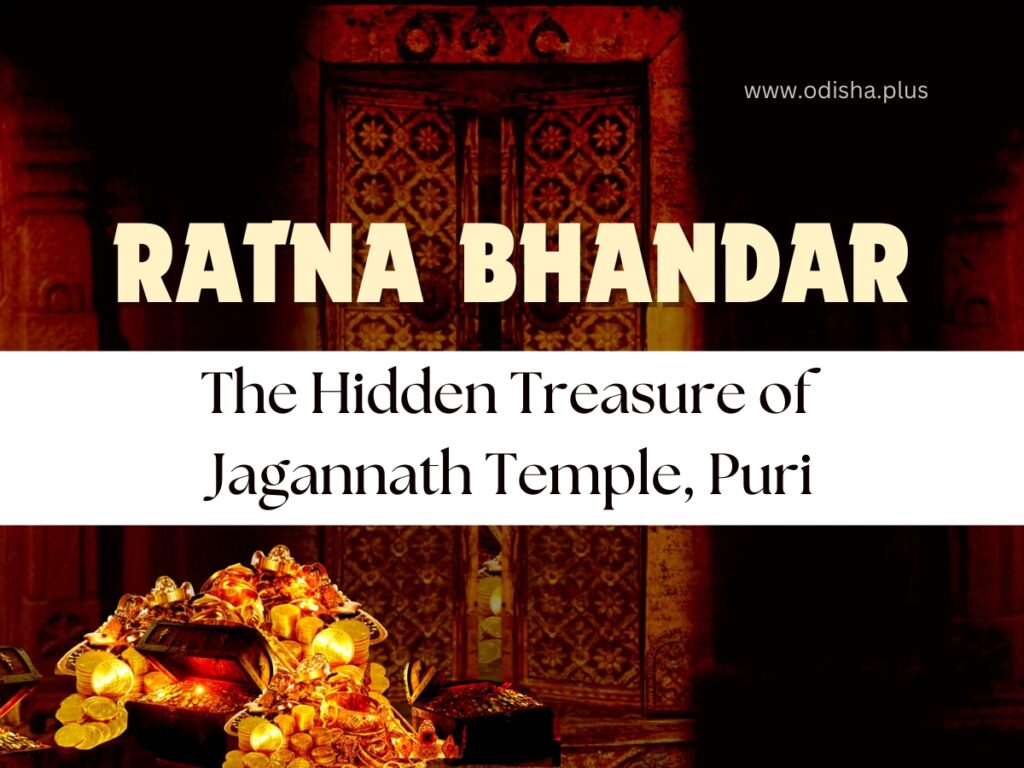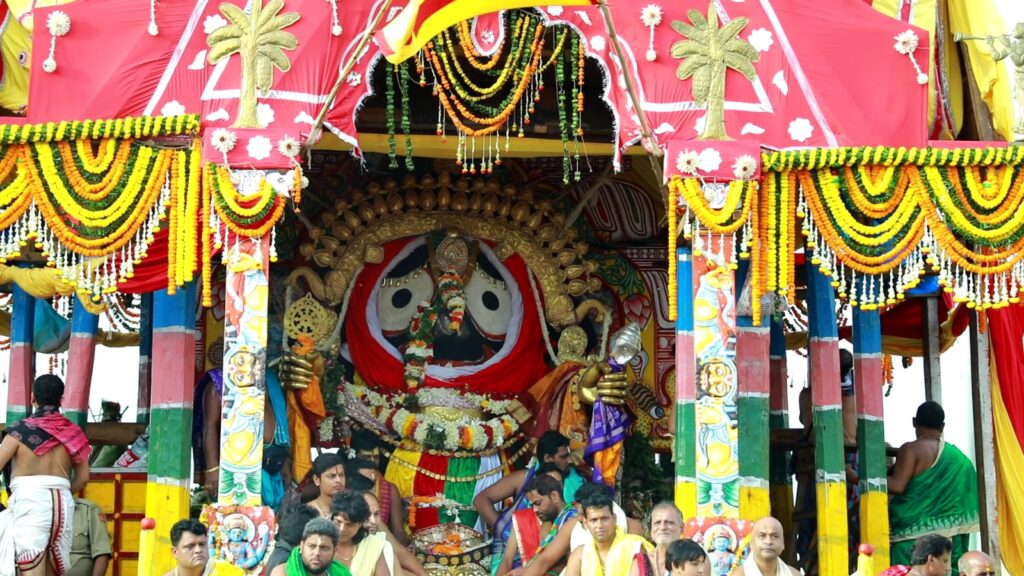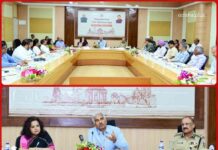The last audit of the Ratna Bhandar in 1978 had revealed a total of 454 gold articles weighing 128.38 kg and 293 silver articles weighing 221.53 kg in both chambers of the treasury.
Bhaskar Parichha

More than four and a half decades after it was last opened for audit, the inner chamber of the Ratna Bhandar or the treasury containing precious jewelleries of Lord Jagannath and his siblings in the 12th century Jagannath temple of Puri was opened on Sunday afternoon, breaking its three locks.
This event marked much anticipation and excitement. The ancient treasure chamber, believed to house priceless jewels, gold, and other valuable artifacts, had been closed off since 1978 due to concerns over its structural integrity. After extensive renovations and safety assessments, the decision was made to unlock the doors and reveal the hidden treasures within.
Treasure Trove
The Ratna Bhandar safeguards the valuable jewellery of the sibling deities – Jagannath, Subhadra, and Balabhadra – contributed by devotees and former rulers over many centuries.
It is segregated into the outer chamber (Bahara Bhandar) and the inner chamber (Bhitara Bhandar). The outer chamber of the shrine from the 12th century is occasionally opened for events like the Suna Besha (golden attire) ceremony during the yearly Rath Yatra.
Situated in close proximity to the Jagamohana of the Jagannath temple, the Ratna Bhandar, which stands at a height of 11.78 meters, with a length of 8.79 meters and a width of 6.74 meters, resembles a temple.
Historical records from the 12th century, such as the “Madala Panji,” indicate that Eastern Ganga monarch Anangabhima Dev III donated over 250 kg of gold, while other kings like Gajapati Kapilendra Dev contributed gold, jewels, and utensils.
During festive occasions, the outer chambers are opened by the servitors to adorn the deities with jewellery. However, the jewels in both chambers have not been audited since 1978, when a committee of nine members, led by the then governor of Odisha B D Sharma, conducted an inventory between May 13 and July 23 of that year. The audit revealed a total of 454 gold articles weighing 128.38 kg and 293 silver articles weighing 221.53 kg in both chambers of the treasury.
The inner chamber contained 367 gold items weighing 43.64 kg and 231 silver items weighing 148.78 kg, while the outer chamber held 87 gold items weighing 84.74 kg and 62 silver items weighing 73.64 kg.
The inner chamber was accessed twice in 1982 and 1985 to retrieve gold and silver jewellery for creating new ornaments for Lord Balabhadra and silver cladding for the gate in the sanctum sanctorum, but no subsequent audit was conducted.
Momentous Occasion
A 12-member team led by chief administrator of the Jagannath temple, Dr. Arabinda Padhee, and comprising former Orissa high court judge Biswanath Rath, Archaeological Survey of India (ASI) superintendent and several temple servitors among others, broke the lock of the inner chamber of the Ratna Bhandar, more than one and a half hours after the team entered the outer chamber of the treasury.
The team then shifted the valuables in four wooden chests from there to a temporary strong room in Changda Mekap room inside the temple premises. However, the team did not open the wooden chests and almirahs in the inner chamber due to paucity of time, as reported.
The reopening of the Ratna Bhandar was a momentous occasion for devotees and historians alike, as it offered a rare glimpse into the temple’s rich history and cultural heritage.
The event was marked by elaborate rituals and ceremonies, with priests and officials carefully inspecting the contents of the chamber and documenting their findings. The treasures found within the Ratna Bhandar were said to be breathtaking, sparking awe and wonder among those present.
The reopening of this sacred space was seen as a significant milestone in the temple’s ongoing legacy, reaffirming its status as a revered place of worship and pilgrimage. The inner chamber contained priceless jewels, gold and silver ornaments, and other valuable items that had been accumulated over centuries.
The team’s successful unlocking of the chamber was a momentous occasion, as it had been shrouded in mystery and speculation for many years.
The treasure trove’s unsealing controversy reached alarming levels under the Biju Janata Dal government, as concerns grew over the secrecy surrounding the treasures stored within. The approach to resolving the issue was unclear, with many accusing the Naveen Patnaik administration of hindering progress and transparency.
The controversy continued to escalate until a change in government finally brought about a resolution. The new administration took swift action to address the concerns surrounding the Ratna Bhandar, ensuring that the treasures were properly accounted for and safeguarded.
This move helped to restore public trust and confidence in the government’s handling of the situation. The uncapping highlighted the importance of transparency and accountability in governance. It also served as a reminder of the need for effective communication and cooperation between government officials and the public in addressing sensitive issues.

Safety & Security
The decision to transfer the valuables to a temporary strong room was made in order to ensure their safety and security while further assessments and inventories were conducted. The team understood the importance of handling the treasures with care and respect, given their historical and cultural significance.
The presence of the Orissa high court judge and ASI superintendent added a level of oversight and accountability to the operation, ensuring that proper procedures were followed and that the valuables were handled in a transparent and responsible manner.
The team’s decision to refrain from opening the wooden chests and almirahs in the inner chamber was a cautious one, as they wanted to proceed with care and thoroughness in order to preserve the integrity of the treasures within. The process of cataloguing and assessing the contents of the Ratna Bhandar would require time and meticulous attention to detail.
The absence of the keys to the inner chamber of Ratna Bhandar has been a significant concern in Odisha since 2018. The then Chief secretary PK Jena led a team in an attempt to open it, but they had to return as the keys were nowhere to be found.
In response to public outcry, the Naveen Patnaik government established a judicial investigation led by retired high court judge Raghubir Das on June 6, 2018, two months after the keys were discovered to be missing. Justice Das presented his inquiry findings to the state government on November 29, 2018. Despite the expenditure of around ₹22.27 lakh on the judicial inquiry, the report was never disclosed to the public.
What the Committee Saw
Head of the audit supervisory committee, justice (retired) Biswanath Rath said the team saw five wooden chests, 4 wooden almirahs and 1 steel almirah in the inner chamber of Ratna Bhandar. “Some dust-like material was also found on floor. Besides, many items were lying on the floor. Many other items might have been there as we did not check the backside of the almirahs,” justice Rath commented before the media.
As the Bahuda Jatra (return car festival of Lord Jagannath and his siblings) was scheduled the next day, it was not possible to transfer the containers from the inner chamber to a temporary strong room in a day. “We need more time for shifting,” added Rath. A he said only after the valuables inside the inner chambers are shifted to a strong room, then the ASI will inspect the structure for its structural safety.
A committee member identified rainwater seepage as a significant issue in the inner chamber, as the floor was wet. Once the ASI completes the repair work, the valuables will be returned to the inner chamber. The audit and inventory of the jewels will only take place inside the inner chamber.
Odia Asmita
Odisha chief minister Mohan Charan Majhi took to social media and expressed his joy at the opening of the treasure trove of Lord Jagannath. Majhi offered prayers to Lord Jagannath seeking blessings for the 4.5 crore people of Odisha. “As per your wish, the Odia race has started moving forward with its Asmita. The four doors of the temple were first opened at your will. Today, after 46 years, your Ratna Bhandar was opened. I strongly believe that this process will be successful achieved,” he wrote on X.
The issue of the Ratna Bhandar and the missing treasury key became a focal point of the election campaign, with the BJP accusing the ruling Biju Janata Dal government of mismanagement and negligence.
The BJP leaders promised to restore transparency and accountability in the administration of the temple treasury, which holds valuable jewels and artifacts. The party’s commitment to conducting a thorough audit and inventory of the treasury resonated with voters who were concerned about the security and preservation of the temple’s treasures.
The BJP’s emphasis on ‘Odia Asmita’ (Odia Pride) and the need to protect the cultural heritage of Odisha struck a chord with many voters who felt that the state government had failed to safeguard the interests of the people. The party’s leaders, including Prime Minister Narendra Modi and Home Minister Amit Shah, rallied support for their campaign by highlighting the importance of preserving the legacy of the Ratna Bhandar and holding the government accountable for its actions.
The outcome of the assembly elections was seen as a referendum on the issue of the Ratna Bhandar, with the BJP’s victory signalling a mandate for change and a demand for greater transparency in governance. The party’s commitment to addressing the concerns of the people and upholding the values of Odia pride resonated with voters who were eager for a new direction in the state’s leadership.
The BJP’s success in the elections was seen as a validation of its promise to prioritize the interests of the people and protect the cultural heritage of Odisha.
The successful unlocking of the inner chamber of the Ratna Bhandar is a significant milestone in the history of the Jagannath temple, and it marked the beginning of a new chapter in the preservation and protection of its invaluable treasures.
The author is a senior journalist and columnist. Views expressed are personal

















